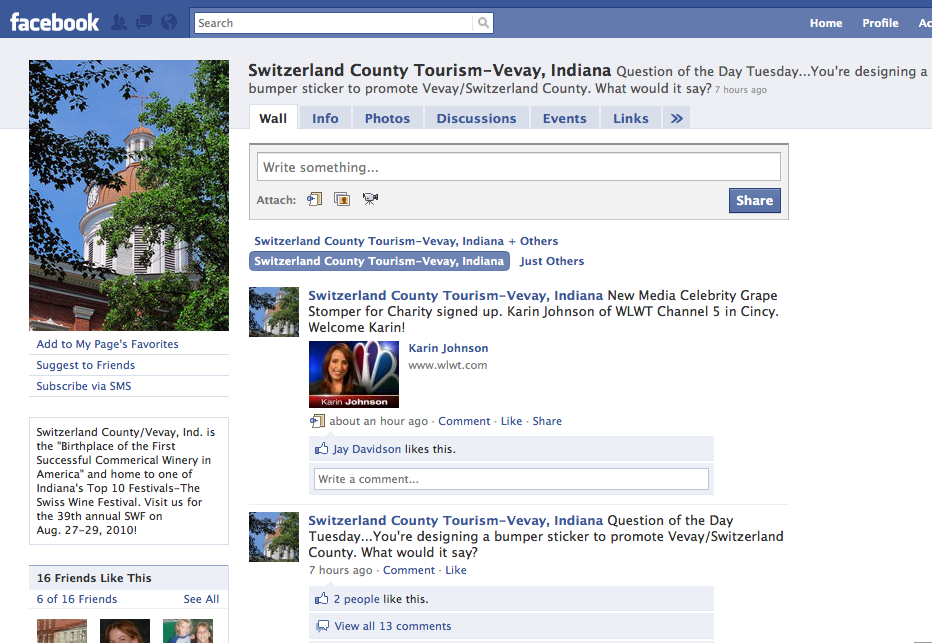4 Ideas for Travel & Tourism Destinations to Get Started in Social Media
This week, I’ve been focusing on how travel and tourism destinations can get started in social media.
(See “5 Reasons Why Travel & Tourism Destinations Need Social Media” and “5 Photo & Video Sharing Sites Travel Destinations Should Use.”)
I probably jumped the gun a little bit by diving into the photo and video sharing sites before I told you how to actually use social media, but that’s okay. For one thing, social networks are created to be soooo easy for everyone to use that you don’t need me to tell you how to get started. Second, you can start these all in a matter of a couple hours, and then start working to integrate them all together. (We’ll discuss that in a future post.)
Clik here to view.

Vevay, IN Facebook page
What it is: It’s the largest social network in the world with 500 million members. If it was a country, it would be the 3rd largest in the world, behind China and India. Basically, if there is an online place where your guests and customers gather, this is it.
Get started: Start out by setting up your own personal profile, and connect with friends and family. Keep this separate from your business or organization. You don’t want to combine your business with your personal life on here.
Strategy: Once you’re comfortable with Facebook, set up a separate business page (what used to be called a “Fan Page”) for your business or destination, and then upload your business email database — you have been saving your guests’ emails, haven’t you? — to build your network. Ask these people to “Like” your page. Start communicating with your page’s network about things going on at your place through status updates, telling people about new photos and videos, new blog posts, and new specials.
Why? The whole foundation of social media is building relationships with people. You want to evoke a positive emotional response in people when the visit your place, and you want to remind them of that emotional response when they see the latest news or photos. If you remind them of the good feelings they had while they were there, they’ll want to experience them again, and will return again.
What it is: It’s a 140 character message that is sent out to your followers (people who have started “following” your messages, because they want to see what you have to say). Twitter is like Facebook’s “Status Updates” but without everything else.
Get started: Go to Twitter.com and sign up for an account, and add your customer list (see Gmail below). Next, download TweetDeck from TweetDeck.com.
Strategy: Communicate the same information you send out on Facebook and your blog by tweeting your headlines and links to events or new posts.
Why? Because not everyone is on Facebook at the same time. Because some people prefer Twitter over Facebook. Because with TweetDeck you can update both Twitter and Facebook at the same time. Because there are a lot of other reasons I will cover in a future post.
Blogging
What it is: Blogging is a way to publish information, like articles and stories, for other people to read and for search engines to find. It’s a way to share photos and videos, without sending people off to Picasa and YouTube (see yesterday’s post, “5 Photo & Video Sharing Sites Travel Destinations Should Use.”)
Get started: Visit Blogger.com or WordPress.com and follow the instructions. You won’t need to upload an address book to find connections.
Strategy: Blog on a regular basis — at least once a week, but preferably more — about what’s going on at your destination or business. Show photos and videos of the fun stuff other people are doing. Talk about any special events or festivals, both before and after they take place. Share testimonials from your guests.
Why? For two reasons: 1) you can rank high in the search engines with a lot of interesting content like this, and 2) it helps your guests feel more connected if they can visit your site and feel like they’re visiting your location. (See the Facebook section above.)
Gmail
What it is: A free email network owned by the folks at Google.
Get started: Set up an account at Gmail.com, and import all of your addresses from your different email profiles, whether it’s Yahoo, Hotmail, your local cable provider, or the address book on your computer. Next, clean it up by eliminating duplicates, deleting out of date entries, and adding missing information.
Strategy: You won’t use this for social networking. You’ll use it for uploading all the addresses of your guests to the other networks. Any new social network you join will let you “see if your friends are on here!” And every social network will plug into Gmail with ease, so this makes it so much easier to build your network in just a couple minutes.
Why? Because you want to have a master list of all your email addresses somewhere other than your computer, in case your computer breaks down.
I was recently in a contest to become the “Inn-Bedded Resorter” at the Balsams Grand Resort Hotel in New Hampshire, and had a chance to be their social media specialist for two months. This was a novel approach, because the Resorter was going to be a guest, do all the guest activities, and then report it via social media. They were starting to use all of these technologies to communicate with their fans and guests, and have seen some great success with these technologies. You ought to give them a try and see what you can do with it.
Professional Blog Service - Number one business blogging agency